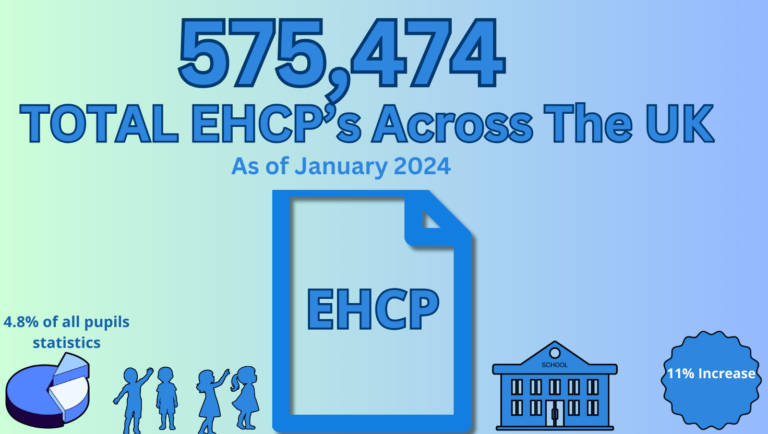EHCP Timelines: A Parent’s Guide to Navigating the Process
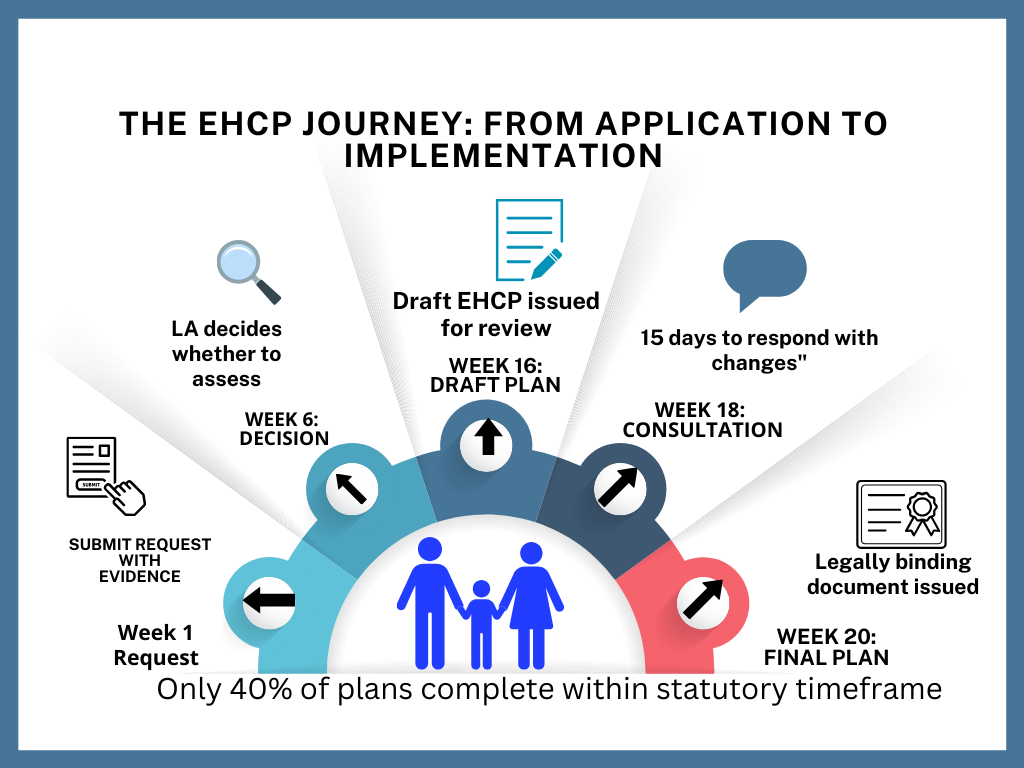
What’s the Real EHCP Timeline Experience for Parents?
EHCP timeline?
More like a rollercoaster ride!
That’s what most parents tell us when describing their journey through the Education, Health and Care Plan process.
While officially set at 20 weeks from request to final plan, over half of families experience longer waits.
We’ve created this straightforward guide based on real experiences to help you understand what happens when you set realistic expectations and keep your child’s application moving forward.
Whether you’re just starting out or stuck somewhere in the middle, here’s what you actually need to know about navigating the EHCP system in 2025.
Disclaimer: This guide provides general information only and is not legal or professional advice. The EHCP process varies by local authority and is subject to change. Consult qualified professionals for specific guidance.
EHCP Timeline Snapshot: Key Points for Busy Parents
Navigating the EHCP process takes persistence – expect 26+ weeks rather than the official 20-week timeline.
When receiving your draft plan, focus on making the support section specific and quantifiable (“3 weekly hours” not “regular support”).
The most critical dates to monitor are: assessment decision (Week 6), draft plan (Week 16), your 15-day response window, and final plan (Week 20).
Document every conversation and follow up weekly to keep things moving.
When delays occur, escalate systematically: informal follow-ups, then formal complaints, then contact higher authorities.
For school transitions, start planning two years ahead rather than waiting until the last minute.
After approval, implementation typically takes another 4 weeks.
Annual reviews must happen every 12 months by law and are your opportunity to update the plan.
Remember that your input as a parent is crucial throughout – no one will advocate for specific, detailed support like you will.
For a deeper dive into the legal framework underpinning the EHCP assessment process, we highly recommend consulting the IPSEA (Independent Provider of Special Education Advice) website.
Their guide, “What happens in an EHC needs assessment” provides a valuable legal perspective, especially on your rights during the assessment phase.
While our guide offers practical tips and a parent’s perspective on managing the overall timeline, IPSEA’s resource is invaluable for understanding the legal obligations of the Local Authority during the assessment.
What are the critical deadlines in the EHCP Timeline process that parents need to know?
The EHCP process follows a statutory timeline with several critical milestones parents should monitor:
- Week 6: Assessment decision deadline
- Weeks 7-16: Professional assessments
- Weeks 16-18: 15-day parent response window
- Weeks 19-20: Final plan issued
The Process: Expectation vs. Reality
- Official: 20 weeks start to finish
- Reality: 60% take longer (average 26+ weeks)
What is an EHCP?
- A Legal document securing special education support
- For children with needs beyond school resources
- Covers education, health and social care to age 25
Parent Essentials:
- Demand specific wording (“3 weekly hours” not “regular support”)
- Document all communications
- Weekly follow-ups prevent delays
- Know escalation: Informal chase → Complaint → Director → Ombudsman
- Section F (Provision) is most critical – focus efforts here
After Approval:
- Implementation takes ~4 weeks realistically
- Annual reviews required by law
- Request mid-year reviews for significant changes
- Plan school transitions 2 years ahead
Remember: No one will advocate for specific, quantified support like you will.
What are the key EHCP timelines parents need to understand?
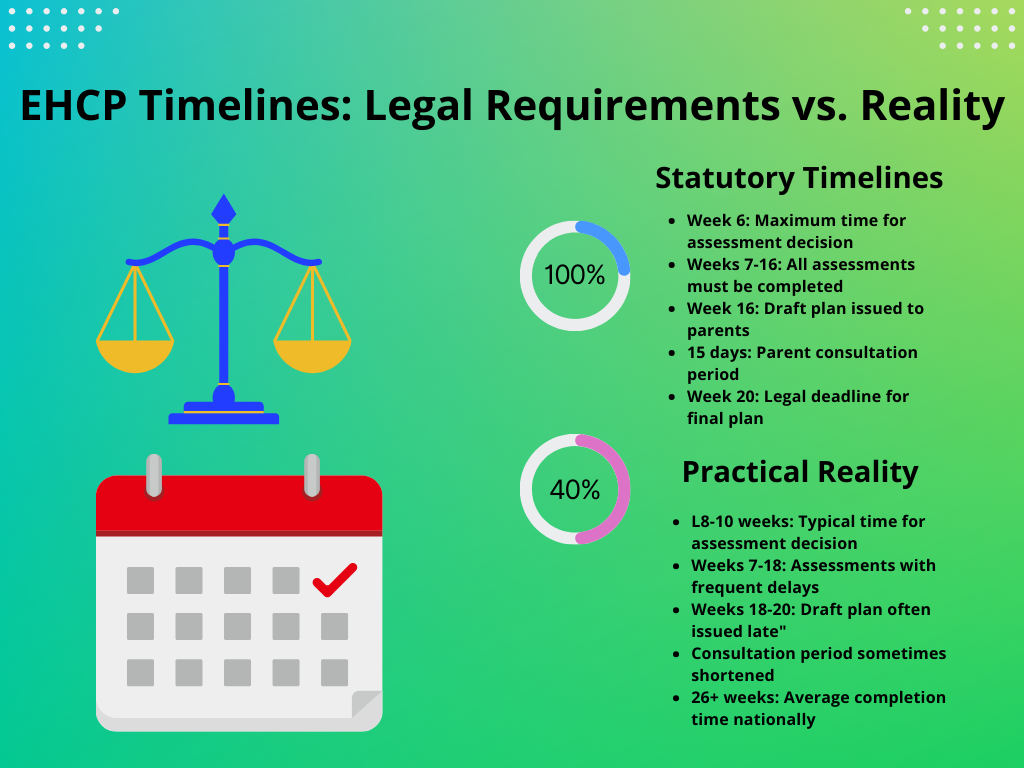
Understanding both the legal requirements and practical realities helps families set realistic expectations and advocate effectively
There are two types of timelines we had to learn about:
- Statutory timelines – these are the legal deadlines that local authorities MUST follow
- Non-statutory timelines – these are more like guidelines
The main legal timeline is 20 weeks from first request to final plan. Knowing these deadlines gave us the power to chase things up when needed!
Who’s Involved?
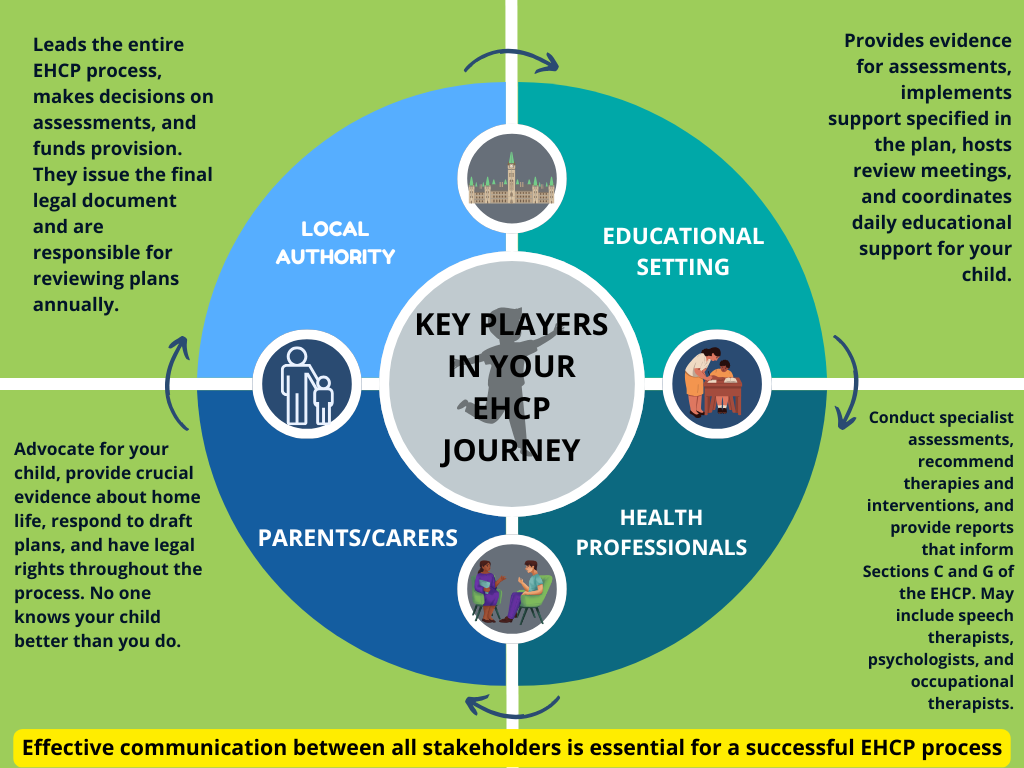
Local Authorities lead the process, Educational Settings implement support, Health Professionals provide specialist assessments and Parents/Carers advocate throughout each stage.
Effective communication between all parties is critical for navigating the EHCP process successfully.
Javon’s EHCP journey involved so many people:
- The local authority (they run the whole process)
- His school and teachers
- Health professionals like speech therapists
- Parents/Carers (playing a crucial advocacy role)
The Children and Families Act 2014
This important law replaced the old Statements with the current EHCP system.
The big difference? EHCPs cover:
- Education
- Health
- Social care needs
They also continue up to age 25 if needed.
This act was meant to give families like ours more say.
The 20-Week Journey
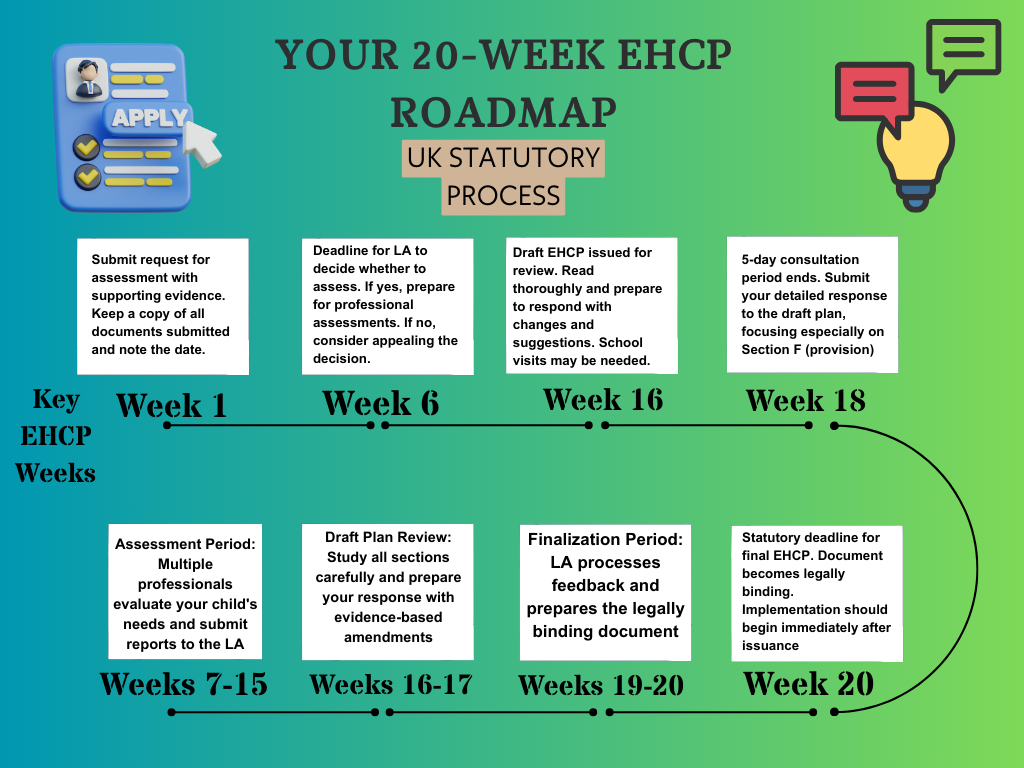
This roadmap shows what happens at each stage: application (Week 1) assessment decision (Week 6), draft plan (Week 16), consultation period (Week 18) and final plan issuance (Week 20).
Understanding these key dates helps you navigate the process and advocate effectively.
This timeframe has been our bible throughout the process:
In reality, Javon’s took nearly 26 weeks – a timeframe that aligns with the experiences of many families navigating the EHCP process.
Having these specific dates written down helped us stay on top of everything and know exactly when to follow up.
What Occurs During the Assessment Period (Weeks 7-16)?
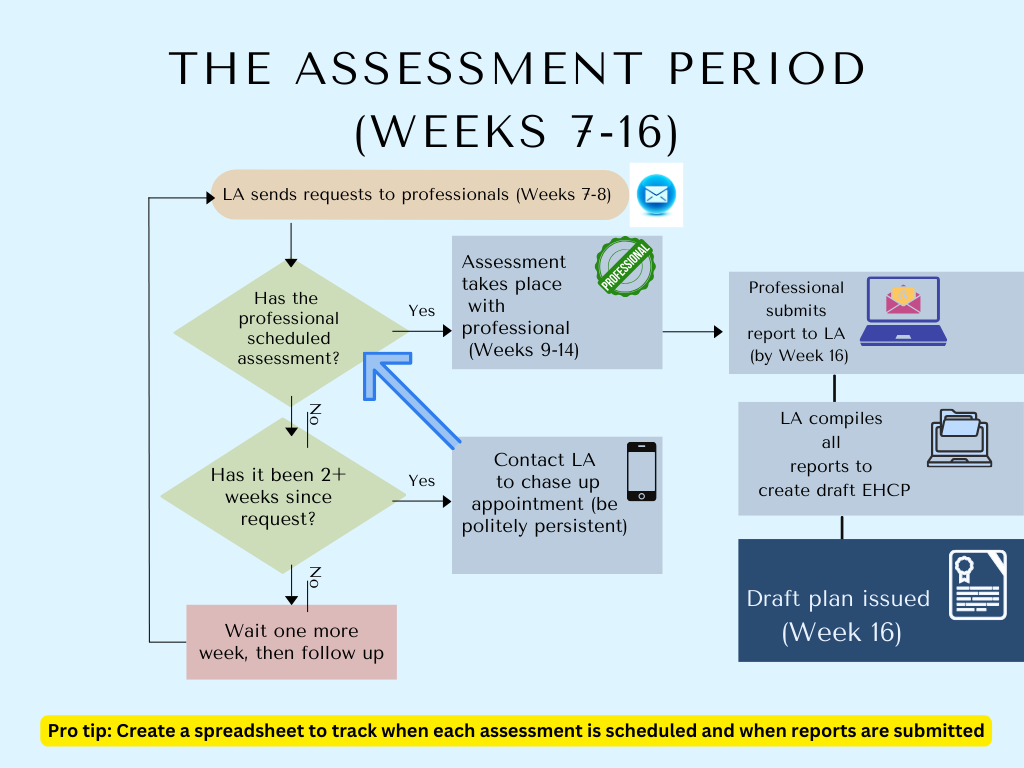
This flowchart shows the process from LA requests to final reports, including what to do if appointments are delayed.
Being “politely persistent” with follow-ups is key to maintaining momentum in your EHCP timeline
Once the local authority agreed to assess Javon, we entered what felt like the longest waiting game of our lives!
Weeks 7-16 are when all the actual assessments happen and honestly, it was both exhausting and eye-opening.
The Local Authority has to gather advice and information from at least three professionals from different disciplines.
For Javon, this meant the LA arranged assessments with an educational psychologist, his speech therapist and an occupational therapist.
Some kids also see pediatricians, physiotherapists, or social workers depending on their needs.”
Which Professionals Make Up the EHCP Assessment Team?
The professionals who assessed Javon each had different approaches:
The Educational Psychologist observed Javon in school for a morning, then worked one-on-one with him using various activities and tests.
She was looking at his learning style, cognitive abilities and how he interacted in the classroom environment.
The Speech and Language Therapist focused on both his understanding of language and his ability to express himself.
They used picture cards, conversation tasks and structured activities that actually felt like games to Javon.
The Occupational Therapist assessed his fine and gross motor skills, sensory processing and daily living skills.
This involved everything from watching how he held a pencil to how he navigated playground equipment.
Depending on your child’s needs, the assessment team may also recommend an autism assessment.
If you suspect your child may be autistic, it’s important to understand your rights in this process.
In the UK, parents have the right to choose their provider for autism assessments, giving you more control over who evaluates your child. Learn more about your ‘right to choose’ for autism assessments in our comprehensive guide.
What rights do parents have during the EHCP process?
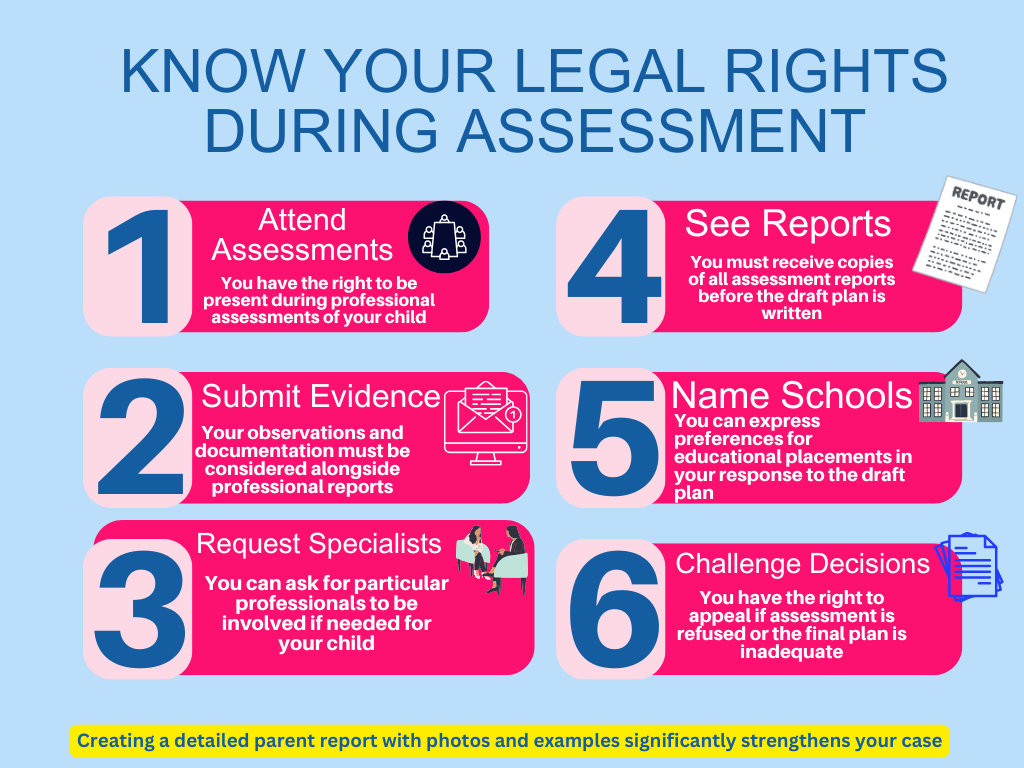
This guide outlines your six key entitlements during assessment, including your right to attend appointments, submit evidence and challenge decisions.
Creating a detailed parent report can substantially strengthen your case.
What nobody told us at the start is that we have LEGAL RIGHTS during this process! We have the right to:
- Attend any assessment meetings if we want to.
- Submit our own evidence about Javon’s needs.
- Request specific professionals be involved if we feel they’re needed.
- See copies of all assessment reports before the draft plan is written.
When Charlene and I realised we could submit our own evidence, we created a detailed document about Javon’s routines at home, complete with photo’s and examples of his work.
This ended up being super valuable!
What happens during EHCP assessments in practice?
Each professional has their own methods, but most used a mix of:
- Direct one-to-one assessments with standardised tools
- Observations in different environments (classroom, playground, home)
- Discussions with us as parents and with Javon’s teachers
- Reviews of previous reports and school work
The educational psychologist’s assessment was the most comprehensive, taking about 3 hours total across different sessions.
The speech therapist saw Javon twice for about 45 minutes each time.
How can you prevent delays during the assessment period?
Here’s what actually happens timing-wise during these weeks:
- Weeks 7-8: LA sends out requests to all professionals
- Weeks 9-14: Most assessments take place (often with weeks of waiting between them)
- Weeks 14-16: Professionals submit their reports to the LA
Some professionals are notorious for missing deadlines and if you don’t keep track, weeks can slip by!
If you haven’t heard anything by Week 10, start making phone calls.
Being politely persistent made a huge difference for us.
When the occupational therapist hadn’t contacted us by Week 12, we called weekly until they scheduled an appointment.
Remember, the clock is ticking during these weeks and every professional needs time to complete their assessment before the draft plan can be written.
Don’t be afraid to be your child’s best advocate – nobody else will chase these appointments like you will!
How do EHCP practices vary between different Local Authorities?
While this guide outlines the general EHCP process, it’s crucial to understand that the reality on the ground can vary significantly depending on the local authority (LA).
Policy Interpretation: Each LA interprets the Children and Families Act 2014 and related guidance (including the SEND Code of Practice) in its own way.
This can lead to inconsistencies in assessment criteria, the level of provision offered and the willingness to agree to parental requests.
Funding Constraints: Local authority budgets for SEND services vary greatly.
This directly impacts the resources available for assessments, therapies and school placements.
Caseloads & Staffing: The workload of SEN officers within LAs influences how quickly they can process applications and respond to queries.
High staff turnover can also disrupt the continuity of cases.
Legal Precedents: Tribunals make decisions on specific cases.
Some tribunal decisions clarify legal principles and influence how all LAs should approach certain issues.
Keep an eye out for key tribunal decisions that might be relevant to your child’s case.
Practical Tip: Research your specific local authority’s policies and procedures on SEND.
Check their website for information on EHCP assessments, personal budgets and school placement policies.
Contact local parent support groups for insights into the LA’s typical practices and any known challenges.
What happens during the Draft Plan and Consultation stage (Weeks 16-18)?
The Draft Plan Arrives!
When we finally received Javon’s draft EHCP, it felt like Christmas and exam results day rolled into one!
Week 16 brought this hefty document to our inbox and Charlene and I immediately cleared our weekend to go through it with a fine-tooth comb.
The draft plan is exactly that – a DRAFT. This means you can and should request changes if it doesn’t accurately reflect your child’s needs or the provision required.
Don’t be afraid to speak up now, as it’s much harder to make changes once the final plan is issued.
Breaking Down the EHCP Sections
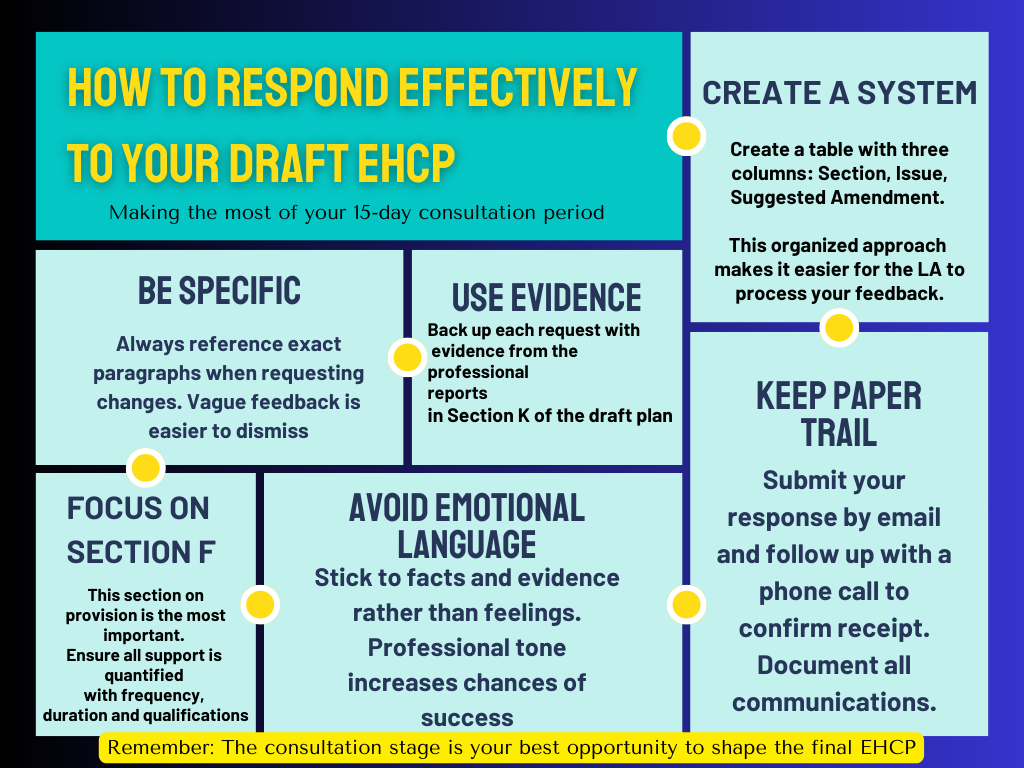
These six strategies—creating a systematic approach, being specific, using evidence, focusing on Section F (provision)
avoiding emotional language and maintaining documentation—will help you maximize this opportunity to shape your child’s final plan.
The draft plan is divided into sections labeled A through K, and each has a specific purpose:
Section A: All about Javon and our views as his parents.
We made sure this truly captured who he is, not just his difficulties.
Section B: Details his special educational needs.
This section should be super specific – vague statements like “communication difficulties” aren’t helpful.
We pushed for details like “struggles to follow multi-step verbal instructions.”
Section C: Any health needs related to his SEN. For Javon, this included sensory processing issues that affected his ability to concentrate in busy environments.
Section D: Any social care needs related to his SEN. This was blank for us, but some children have social care needs too.
Section E: The outcomes everyone is working towards. We checked these were specific, measurable and actually achievable within the timeframe.
Section F: The special educational provision – the actual support Javon will receive. This is the MOST IMPORTANT section! We made sure everything was quantified (e.g., “3 hours per week of 1:1 support” not just “regular support”).
Sections G and H: Health and social care provision related to the needs in sections C and D.
Section I: Placement – this is where they name the school. It was blank in our draft as we hadn’t decided yet.
Section J: Personal budget arrangements if applicable.
Section K: The appendices – all the reports from professionals who assessed Javon.
What Are Your Consultation Rights in the EHCP Timeline?
We had 15 calendar days (not working days!) to respond to the draft plan. During this time, we:
- Highlighted anything that was missing or inaccurate
- Asked for clarification on vague statements
- Requested more specific provision where needed
- Researched potential schools for Section I
The LA is legally required to consider our views before finalizing the plan.
When we submitted eight pages of notes and requested changes, they actually thanked us for being thorough!
How to Respond Effectively
Here’s what worked for us:
- Create a table with three columns: Section, Issue, Suggested Amendment reference specific paragraphs when requesting changes
- Back up each request with evidence from the professional reports in Section K
- Be specific about what provision you want added or changed
- Avoid emotional language – stick to facts and evidence
We submitted our response by email and followed up with a phone call to confirm receipt.
Keeping everything in writing creates a paper trail if you need it later.
How do you choose the right school for your EHCP child?
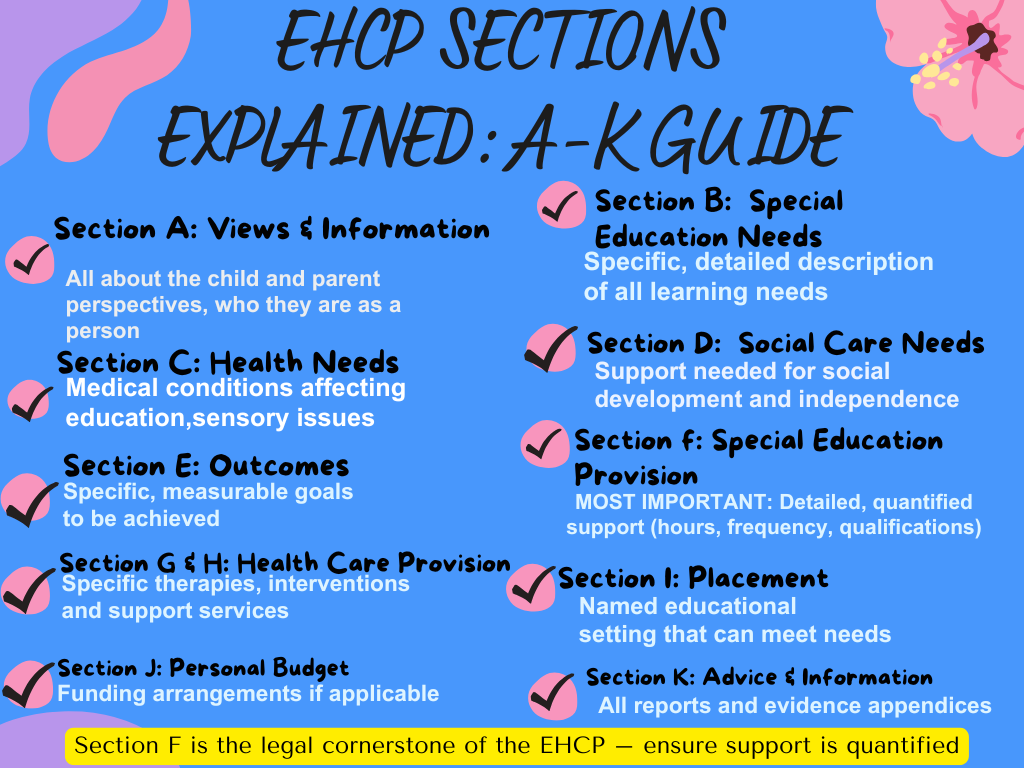
This guide explains all sections A-K, highlighting Section F (Special Educational Provision) as the most important component requiring specific, quantified support details.
Use this reference during your 15-day consultation period to ensure your child’s plan is properly structured.
This was the most stressful part for us. During these weeks, we:
- Visited three potential schools
- Spoke to SENCOs at each one
- Asked about their experience with children like Javon
- Considered practical issues like transport and after-school provision
You have the right to request any school, but the LA can refuse if it’s unsuitable for your child’s needs or would be an inefficient use of resources.
We listed our preferred school plus a backup option.
Timeline Tips for Weeks 16-18
- Day 1: Initial read-through of the draft
- Day 3-7: Detailed analysis and note-taking
- Day 8-10: School visits if needed
- Day 11-13: Finalise your response document
- Day 14: Submit your response
- Day 15: Follow up to confirm receipt
Stage 4: Final EHCP Issuance (Weeks 19-20)
The Final Countdown
After submitting our response to Javon’s draft plan, Charlene and I were on pins and needles waiting for the final version!
Weeks 19-20 are when the local authority takes all the feedback they’ve received and finalizes the document.
For us, this period felt like the longest two weeks of the entire process.
During this time, the LA reviews parent/carer comments, school preferences and any additional evidence submitted.
They then make decisions about what changes to include and what to reject.
We were surprised to learn they don’t have to accept all our suggestions – but they do need to consider them and explain their decisions.
How Should You Respond to EHCP Timeline Delays?
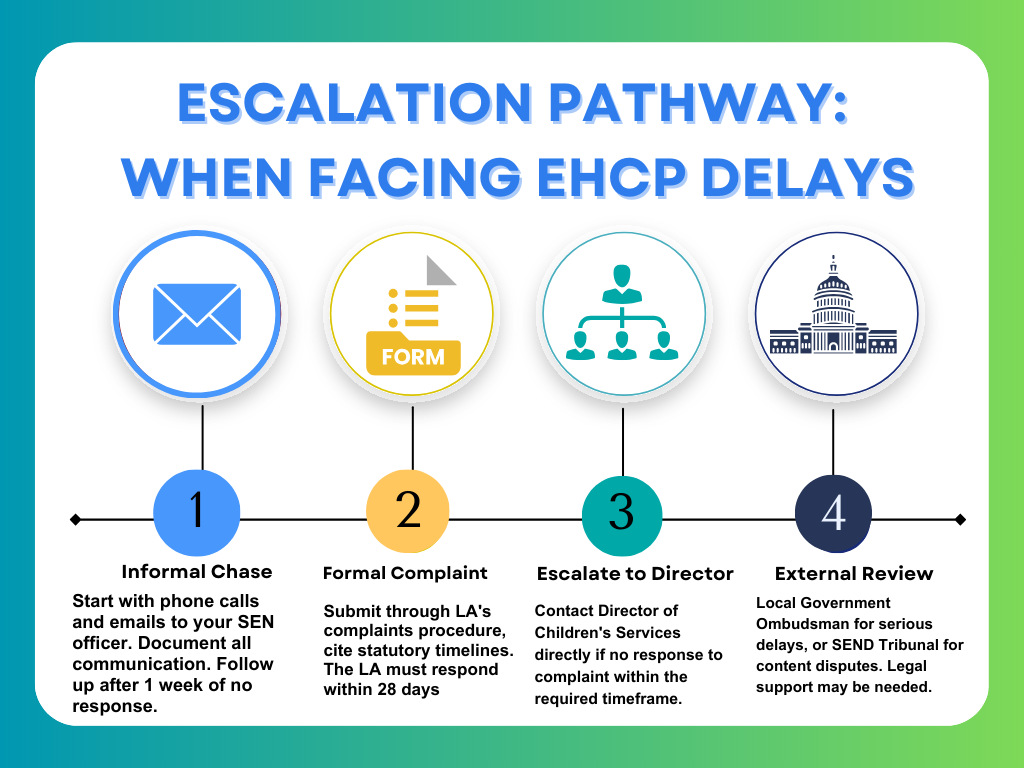
Start with informal communication, progress to formal complaints if needed, escalate to leadership when necessary and pursue external review as a last resort.
Being polite but persistent while citing specific statutory timelines is key to moving the process forward.
When the final EHCP arrived for Javon, it came with something the draft didn’t have – legal status.
The moment the LA issues the final plan, it becomes a legally binding document. This means the specified support MUST be delivered and we can hold people accountable if it isn’t!
The final plan had an issue date, signature from the LA’s SEN officer and a notice about our right to appeal if we weren’t satisfied.
These elements transform it from a proposal into a legal entitlement for Javon.
The power of this document honestly took us by surprise!
Precision Pays Off: The Importance of Detailed Wording
One massive lesson we learned: vague wording is the enemy of a good EHCP! The final plan is only as good as its specificity and quantification.
For example, when Javon’s draft said he needed “regular speech therapy,” we pushed for it to specify “direct speech and language therapy for 30 minutes weekly in a small group setting.
This makes all the difference when it comes to implementation.
We also made sure time allocations, group sizes and staff qualifications were clearly stated.
After chatting with other parents, we discovered that phrases like “as needed” or “regular support” often translate to “whenever we can fit it in” – which isn’t good enough!
What are the Key Differences between Draft and Final Plans?
Comparing Javon’s draft and final plans revealed several key differences:
- The final plan named his school in Section I
- Most of our requested clarifications in Section F were included
- Some provision was more specific (hours, frequency, qualifications)
- A personal budget section was added that wasn’t in the draft
- Appeal rights information was attached
What surprised us was that some of our requested changes weren’t included, with no explanation why.
We later learned we could have asked for written reasons for these decisions.
When the Clock Strikes 20 Weeks
The LA is supposed to issue the final plan within the 20-week statutory timeframe.
In reality, Javon’s took 22 weeks from start to finish. When the 20-week deadline passed, we:
- Called the SEN department for an update
- Asked for a specific date when the plan would be finalized
- Mentioned we were aware of the statutory timeframe
- Kept a log of all communications
Had it dragged on much longer, we could have complained to the LA formally or even contacted our local councillor.
Some parents we know have gone to the Local Government Ombudsman when delays were excessive.
The important thing to remember is that missing the deadline doesn’t invalidate the process – the LA still has to complete the EHCP.
But keeping gentle pressure on can help move things along.
When Javon’s final plan finally arrived, despite the extra two weeks of waiting, the relief was enormous.
All those assessments, meetings and paperwork had culminated in a document that would help secure the support he needed.
The journey wasn’t over – implementation would bring its own challenges – but reaching this milestone felt like winning a marathon!
What Legal Options Do You Have if You Disagree with EHCP Decisions?
The EHCP appeals process has two main routes:
complaints about delays or procedural issues can be taken to the Local Government Ombudsman (LGO),
while disputes about the content of an EHCP must be appealed through the SEND Tribunal system.
SEND Tribunal: If you disagree with the LA’s decision at several key stages, you have the right to appeal to the Special Educational Needs and Disability (SEND) Tribunal. This includes:
- Refusal to assess
- Refusal to issue an EHCP after an assessment
- The contents of the EHCP (Sections B, F, I in particular)
- Amendments made to an existing EHCP
Time Limits: Appeals to the SEND Tribunal must be made within two months of the date of the LA’s decision letter or one month from the date of mediation certificate if you choose to go through mediation.
Mediation: Before lodging an appeal, you must contact a mediation advisor. Mediation is not compulsory, but you must consider it.
Tribunal Outcomes: The Tribunal has the power to order the LA to:
- Conduct an assessment
- Issue an EHCP
- Amend the contents of the EHCP
- Name a specific school in the EHCP
Judicial Review:
In rare cases, if the LA has acted unlawfully in its decision-making process (e.g., failed to follow proper procedures), you may be able to apply for a judicial review in the High Court.
This is a complex legal process and requires specialist legal advice.
- Practical Tip: Seek legal advice from a solicitor specializing in SEND law if you are considering an appeal to the SEND Tribunal or a judicial review.
- Organizations like IPSEA (Independent Provider of Special Education Advice) offer free legal advice and support to parents.
What Happens After the EHCP Timeline is Complete?
Realistic Timeframe: Current Data & Delays
While the statutory timeline for an EHCP remains 20 weeks, current data shows that delays are common. It’s important to have realistic expectations.
Current Statistics (as of early 2025 – Note: Based on the most recent available data):
SEND Tribunal Appeals:
The number of appeals to the SEND Tribunal continues to be high.
In the 2022-2023 period, there were 13,700 appeals, a 24% increase compared to the previous year, indicating ongoing dissatisfaction with Local Authority decision-making. (https://www.gov.uk/government/statistics/tribunals-statistics-quarterly-october-to-december-2023)
Reasons for Delays: Common reasons for delays include:
- High caseloads of SEN officers
- Difficulties obtaining assessment reports from professionals (e.g., educational psychologists, therapists)
- Disagreements between parents and the LA about the child’s needs or the appropriate provision
- School placement disputes
Proactive Steps: To minimize delays, parents should:
- Track all communication with the LA and professionals.
- Be proactive in chasing up assessments and reports.
- Submit all information and evidence promptly.
- Consider seeking support from an independent advocate.
When communicating with the LA, always be polite but persistent. Keep a detailed record of all correspondence, including dates, times and the names of the people you spoke to.
If deadlines are missed, write a formal letter of complaint to the head of the SEN department.
How Do Personal Budgets Work with EHCPs?
Personal budgets are an important part of the EHCP process, giving families more control over how some of the provision in the plan is delivered.
However, they can be complex.
A personal budget is an amount of money identified to deliver some of the provision set out in an EHCP. It is not intended to replace existing LA funding for SEN services.
What can it be used for?
Personal budgets can be used to fund a range of services, such as:
- Therapies (e.g., speech therapy, occupational therapy)
- Personal assistants to provide support at home or in school
- Specialist equipment
- Short breaks (respite care)
Types of Personal Budgets:
There are four ways to manage a personal budget:
- Direct Payment: You receive the money directly and are responsible for arranging and paying for the services.
- Managed by the LA: The LA holds the budget and arranges the services on your behalf.
- Third Party Arrangement: An organization (e.g., a charity) holds the budget and manages the services.
- A combination of the above.
Right to a Personal Budget:
You have the right to request a personal budget, but the LA doesn’t have to agree to it. They can refuse if they believe it’s not the best way to meet the child’s needs or if it’s not a good use of resources.
- Challenging Refusal: If the LA refuses to grant a personal budget, you can challenge this decision through the LA’s complaints procedure and ultimately, through the SEND Tribunal if it relates to the special educational provision in Section F of the EHCP.
Practical Tip: When requesting a personal budget, be clear about what services you want to fund, how they will meet the needs outlined in the EHCP and why you believe a personal budget is the best way to deliver that provision.
How Will the SEND Implementation Plan Affect EHCPs?
- It is important to address the reforms outlined in the plan to create a more inclusive and effective system that will better meet the needs of children and young people with SEND across the country.
Reforms: The plan sets out a series of reforms, including:
- Establishing new standards for provision that will drive up quality and ensure children and young people benefit from the right support, in the right place at the right time.
- Delivering ambitious changes to improve mainstream inclusion.
- Overhauling the EHCP process to ensure plans focus on outcomes and are delivered in a timely way.
Key changes: The reforms will be underpinned by legislative changes, including:
- Mandatory mediation before tribunals, to encourage collaborative dispute resolution.
- A strengthened role for Ofsted, to hold local areas to account for their SEND provision.
- A new national framework for funding SEND, to ensure resources are targeted where they are needed most.
Practical Tip:
Stay updated on the plan’s progress and how the reforms may impact your child’s EHCP. Engage with local parent groups to share experiences and advocate for effective implementation in your area.
What Does the EHCP Annual Review Timeline Look Like?
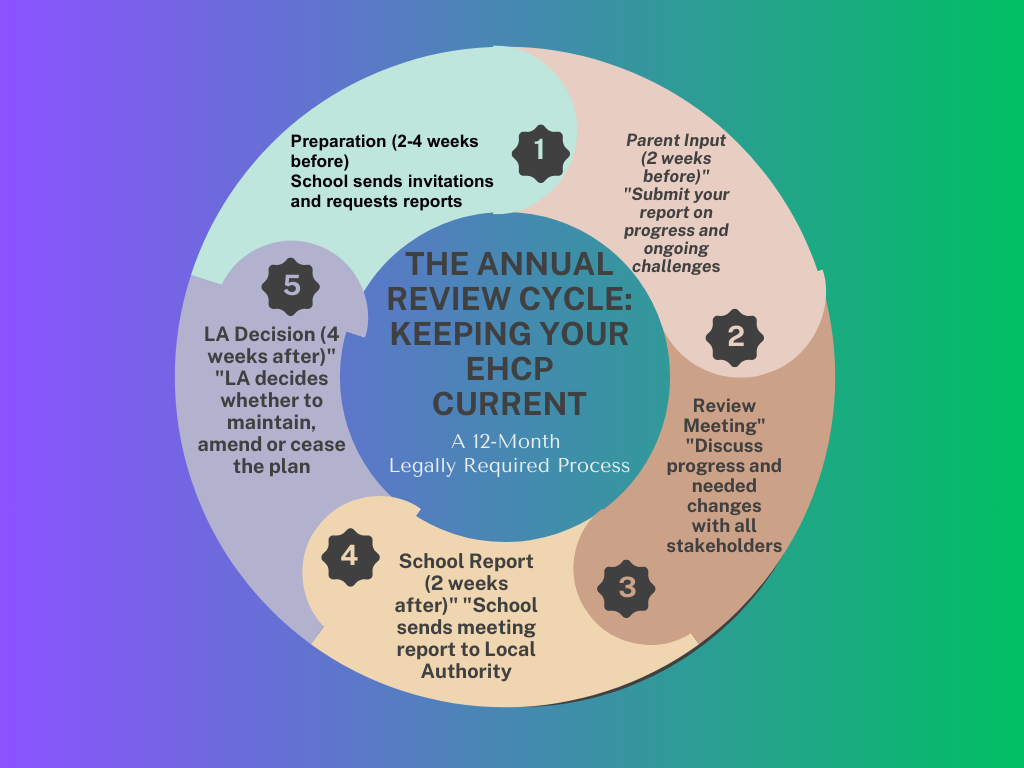
This cycle shows the five key stages: preparation by the school, your input as parents, the review meeting itself, the school’s report and the LA’s decision about maintaining or amending the plan.
Understanding these timeframes helps you stay actively involved in keeping your child’s EHCP current and effective.
- Every EHCP must be reviewed at least once per year – this is a legal requirement, not optional!
- For Javon, his first annual review was scheduled 11 months after his final plan was issued, to allow time for paperwork to be processed before the 12-month deadline.
The annual review timeline looks like this:
- 2 weeks before: School sends out invitations and requests reports
- The meeting: Everyone discusses progress against outcomes and whether changes are needed
- 2 weeks after: School sends report of the meeting to the LA
- 4 weeks after: LA decides whether to maintain, amend or cease the plan
- 8 weeks after: If amending, LA must issue draft amendments
What nobody told us was that we could submit our own report before the meeting.
We prepared a 2-page summary of Javon’s progress at home and the challenges we were still seeing.
This became a valuable part of the discussion and was included in the official documentation.
When Things Can’t Wait a Year
Sometimes, waiting for the annual review isn’t practical.
For Javon, we requested a mid-year review when his anxiety levels suddenly increased, affecting his ability to access education.
Situations that might warrant a mid-year review include:
- Significant changes in needs or circumstances
- Provision that isn’t working as expected
- New diagnoses or medical information
- A placement that’s breaking down
There’s no statutory timeline for mid-year reviews, but the Local Authority should respond to your request within a reasonable timeframe.
For us, it took 6 weeks from our request to an actual meeting being held.
Making Amendments to the Plan
After Javon’s first annual review, several amendments were needed to his EHCP.
The process isn’t as lengthy as the original 20 weeks, but it still has specific timelines:
- 4 weeks for the LA to decide whether to amend after the review meeting
- 8 weeks to issue draft amendments if they agree changes are needed
- 15 days for parents/carers to respond to draft amendments
- 8 weeks to issue the final amended plan
In total, the amendment process can take up to 20 weeks from the review meeting to receiving the final amended plan.
When Javon’s provision needed urgent changes, we agreed with the school to implement them immediately, while the paperwork caught up.
How Should You Plan for Transitions in the EHCP Timeline?
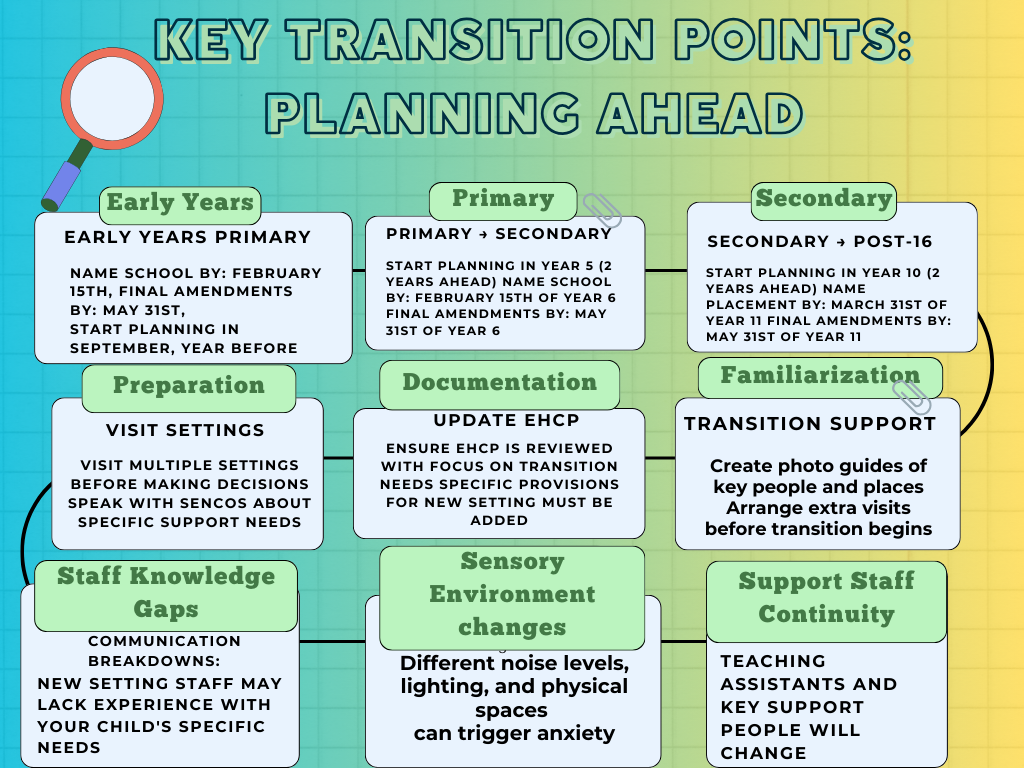
This guide outlines key statutory dates (February 15th for naming schools, May 31st for amendments), essential preparation activities and common challenges.
Starting preparations early—in Year 5 for secondary transitions and Year 10 for post-16—helps ensure appropriate support continues seamlessly as your child moves between educational settings.
Transitions between educational phases are particularly critical times for children with EHCPs.
For Javon, moving from primary to secondary school required careful planning.
Key transition points each have their own timelines:
Early Years to Primary:
- Name school by February 15th of the year of admission
- Amendments should be finalized by May 31st
Primary to Secondary:
- Name school by February 15th of the year of admission
- Amendments should be finalized by May 31st
Secondary to Post-16:
- Name placement by March 31st of the year of transition
- Amendments should be finalized by May 31st
We’re planning to start visiting potential secondary schools next year when Javon will be in Year 5, giving us a full two years before the transition.
Most parents begin this process in Year 6, but we’ve learned that children with EHCPs benefit from much more preparation time.
This extra year will give us plenty of time to find the right environment and avoid a last-minute rush.
For transitions like this, the EHCP must be reviewed and amended to include provision and outcomes relevant to the new setting.
We’ve heard from other parents that visiting the new school multiple times and creating a photo book of key people and places can help ease anxiety
about the change – something we’ll definitely do with Javon when the time comes.
The journey doesn’t end when you receive the final EHCP – in many ways, it’s just beginning.
But armed with knowledge about implementation, reviews and amendments,
you’ll be better equipped to ensure your child receives the support they’re legally entitled to throughout their education.
How Can You Handle Delays in the EHCP Timeline Process?
The Reality of Waiting Times
When we started Javon’s EHCP journey, we had no idea that the “20-week timeline” was more of an aspiration than a reality for most families!
The latest government data shows that only 40% of new EHCPs are issued within the statutory 20-week period, with huge variations across different local authorities.
In some areas, the average waiting time stretches to 30+ weeks, while a few high-performing authorities manage to hit the 20-week target for most cases.
Our own Local Authority completes about 45% of plans on time, which is slightly better than the national average but still means most families face delays.
These statistics aren’t just numbers – they represent real children waiting for support they’re legally entitled to receive.
Knowing the average timeline in your area helps set realistic expectations and plan accordingly.
What Legal Rights Do You Have When the EHCP Timeline is Delayed?
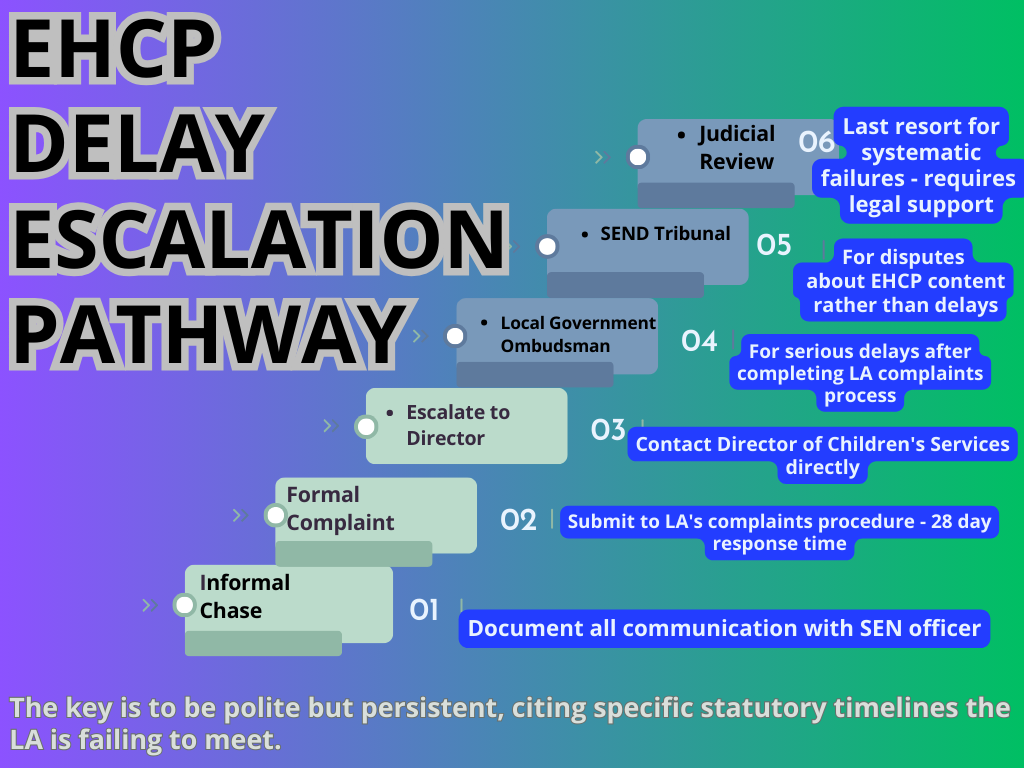
When Javon’s assessment process stalled around week 18, we had to quickly educate ourselves about our legal options.
If you’re facing delays, there’s a clear escalation path you can follow:
- Informal Chase: Start with phone calls and emails to your SEN officer. Document all communication.
- Formal Complaint: If no response after 2-3 attempts, submit a formal complaint using the LA’s complaints procedure. They must respond within 28 days.
- Escalate to Director: If the complaint doesn’t resolve things, escalate to the Director of Children’s Services.
- Local Government Ombudsman: For serious delays or failures, the LGO can investigate and recommend remedies.
- Judicial Review: In extreme cases, legal action can be taken, though this requires legal support.
We found that a formal complaint was enough to get things moving again after weeks of silence.
The key is to be polite but persistent, citing the specific statutory timelines the LA is failing to meet.
COVID-19 Impact and Recovery
The pandemic created a perfect storm for EHCP delays.
Schools closed, professionals couldn’t conduct face-to-face assessments and Local Authority staff worked remotely with limited access to systems.
During 2020-2021, some local authorities were taking 40+ weeks to complete EHCPs.
While things have improved since then, many are still working through backlogs.
For Javon, several of his assessments were conducted virtually, which wasn’t ideal but kept the process moving forward.
If you’re told delays are due to pandemic recovery, don’t simply accept this as unchangeable:
- Ask for specific timelines despite the delays
- Request interim support while waiting
- Check if assessments can be done differently (virtually if in-person is delayed)
- Remember that statutory duties remained in place even during the pandemic
The good news is that most services have adapted their processes and recovery plans are in place, though the effects will likely continue through 2025.
Practical Strategies That Actually Work
Through Javon’s journey and talking with other parents, we’ve developed some effective techniques for keeping things moving:
- The Weekly Check-in: Send a brief, polite email every Thursday asking for an update. Consistency works better than occasional frustrated calls.
- The Paper Trail: Keep records of EVERYTHING. We created a simple log with dates, who we spoke to, and what was promised.
- The CC Method: Copy in supervisors or managers on follow-up emails after repeated delays. This often produces surprisingly quick responses!
- The Deadline Question: Always ask, “When exactly can I expect this to happen?” Get specific dates, not vague promises.
- The Broken Record: Politely repeat the same question until you get a satisfactory answer. “I understand there are challenges, but I need to know when this assessment will be scheduled.”
When Javon’s educational psychology assessment was repeatedly delayed, our weekly emails finally resulted in them finding a cancellation slot and fitting him in.
When to Bring in Reinforcements
Sometimes, despite your best efforts, you need additional support. For us, that moment came when the final plan was delayed with no explanation.
Here’s when to consider getting help:
- When you’ve gone through the formal complaint process without resolution
- When deadlines are repeatedly missed without explanation
- When communication breaks down completely
- When you’re confused about your legal rights
- When you need to appeal a decision
SENDIASS (Special Educational Needs and Disability Information Advice and Support Service) offers free, impartial advice and can sometimes intervene to help resolve issues.
They can help you understand your options if you’re unsure about the provisions in your child’s plan or if you encounter obstacles in the process
Legal support becomes necessary if you’re heading to tribunal or considering judicial review.
Some law firms offer free initial consultations and organization like IPSEA provide legal information and templates.
Legal aid is available for some tribunal cases, though eligibility is limited.
We ultimately didn’t need legal support, but knowing it was available gave us confidence in pushing for what Javon needed.
Sometimes just mentioning you’re “seeking legal advice” can make an Local Authority more responsive.
The EHCP journey is as much about persistence as it is about patience.
When delays happen – and they will – having a toolkit of responses ready helps you advocate effectively without burning out in the process.
How Can You Turn the EHCP Timeline Process into Real Progress for Your Child?
Understanding the EHCP timeline is crucial for effectively advocating for children with special educational needs and disabilities.
While the statutory 20-week process provides a framework, being prepared for each stage enables families and professionals to navigate potential challenges with confidence.
Remember that the journey doesn’t end with obtaining the plan – implementation and regular reviews are equally important parts of the process.
By familiarising yourself with the timeline outlined in this guide, you’re taking a significant step toward securing appropriate support for your child or the children in your care.
Don’t hesitate to reach out to support services like SENDIASS if you need additional guidance through this complex but rewarding process.
EHCP Timeline FAQs
About the Authors: Dwayne and Charlene are committed to providing accessible and reliable information to families with special needs. Charlene’s extensive experience working with children of all abilities as a professional childminder combines with Dwayne’s personal journey as a father to their son with autism to provide families with a deep understanding of the issues families face. Together, they offer practical guidance and support.
